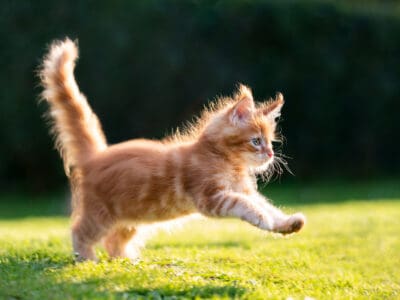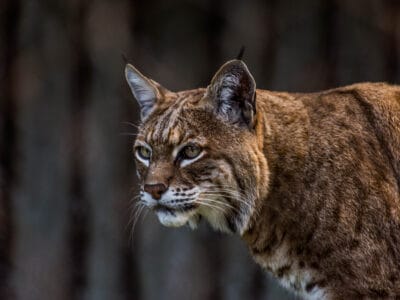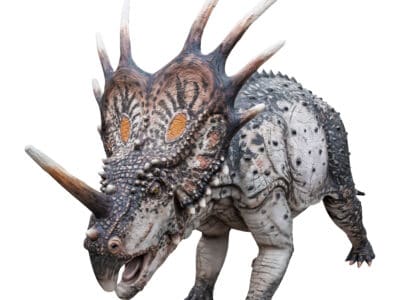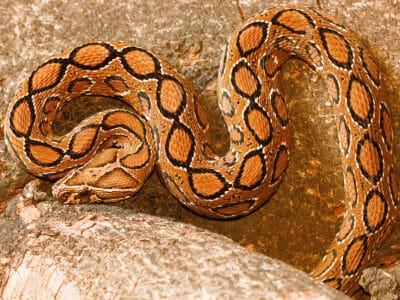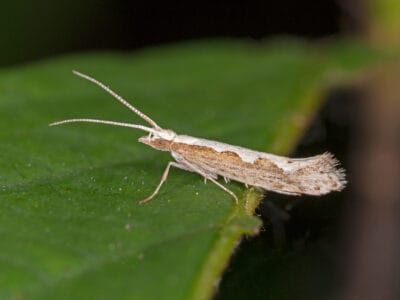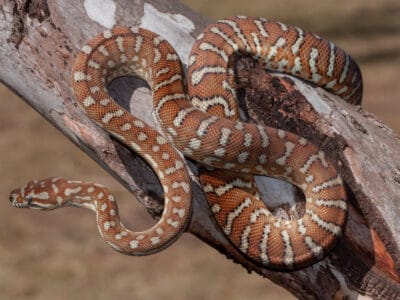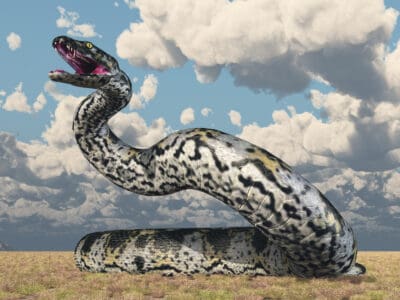Texas Spiny Lizard
.jumbotron {
background-image: url(“https://a-z-animals.com/media/2022/02/Texas-Spiny-Lizard-header-400×300.jpg”);
}
}
@media only screen and (min-width: 641px) and (max-width: 920px) {
.jumbotron {
background-image: url(“https://a-z-animals.com/media/2022/02/Texas-Spiny-Lizard-header-470×370.jpg”);
}
}
@media only screen and (min-width: 921px) {
.jumbotron {
background-image: url(“https://a-z-animals.com/media/2022/02/Texas-Spiny-Lizard-header.jpg”);
}
}
Texas Spiny Lizard
Sceloporus olivaceous
They hold push-up competitions!
Texas Spiny Lizard Scientific Classification
- Kingdom
- Animalia
- Phylum
- Chordata
- Class
- Reptilia
- Order
- Squamata
- Family
- Phrynosomatidae
- Genus
- Sceloporus
- Scientific Name
- Sceloporus olivaceous
Read our Complete Guide to Classification of Animals.
Texas Spiny Lizard Conservation Status
Texas Spiny Lizard Facts
- Prey
- Beetles, wasps, grasshoppers
- Name Of Young
- Hatchling
- Group Behavior
-
- Solitary
- Fun Fact
- They hold push-up competitions!
- Estimated Population Size
- Unknown
- Biggest Threat
- Predators
- Most Distinctive Feature
- Blue patches on male’s belly
- Other Name(s)
- Tree lizard, fence lizard
- Gestation Period
- 90 to 100 days
- Litter Size
- 4 to 20
- Habitat
- Forests, scrublands, backyards
- Predators
- Snakes, raptors, weasels, lizards
- Diet
- Carnivore
- Type
- Reptile
- Common Name
- Texas spiny lizard
- Number Of Species
- 10
- Location
- Mexico, U.S.
- Group
- Lounge
Texas Spiny Lizard Physical Characteristics
- Color
-
- Brown
- Grey
- Black
- White
- Skin Type
- Scales
- Top Speed
- 35 mph
- Lifespan
- 2 to 7 years
- Height
- 2 inches
- Length
- 8 to 12 inches
- Age of Sexual Maturity
- 1 year
- Age of Weaning
- At birth
This post may contain affiliate links to our partners like Chewy, Amazon, and others. Purchasing through these helps us further the A-Z Animals mission to educate about the world’s species..

Spiders that fly! Fish that walk! And 1000+ more incredible animals. Discover them all for FREE
.photo-gallery {
–margin: 0px auto 0px;
–padding: 0px 0px 0px 0px;
}
.gallery-link {
background-image: url(“https://a-z-animals.com/media/2022/02/Texas-Spiny-Lizard-header-1024×535.jpg”);
background-repeat: no-repeat;
background-size: cover;
background-position: center;
height: 500px;
justify-content: center;
text-align: center;
align-items: center;
display: flex;
border: 2px solid #000;
}
.gallery-link img {
height: 50%;
}
@media only screen and (max-width: 768px) {
.gallery-link {
height: 300px !important;
}
}
View all of the Texas Spiny Lizard images!
The Texas spiny lizard is a small reptile native to Mexico and the south-central region of the United States.
It prefers to live in mesquite trees and lowland areas that have heavy ground leaf cover. The spiny lizard is a common visitor to backyards and on fences in Oklahoma, Texas, and Arizona. With a slender body and long tail, this spiny visitor helps people keep bugs out of their yards and homes.
4 Fun Facts About the Texas Spiny Lizard
- Male spiny lizards compete by doing push-ups.
- Spiny lizard hatchlings can fend for themselves at birth.
- The Texas spiny lizard’s preferred habitat is a mesquite tree.
- If they lose their tails, they can regrow them.
Scientific Name
The scientific name of the Texas spiny lizard is Sceloporus olivaceus.
Texas Spiny Lizard Appearance
The Texas spiny lizard has large, clearly defined scales. It is usually a dark gray color with a light grey belly. It has long toes ending in sharp claws that are ideal for its life among the trees. The spiny lizard enjoys climbing trees and digging into rotted wood, so those claws come in handy.
Male and female spiny lizards look alike, with a few differences in colors. Males have small blue patches on their bellies that females don’t have.
Identification of a Texas spiny lizard
Since there are many lizards in the Southeastern U.S. and Mexico, use these clues for identification of a spiny lizard:
- Length of 8 to 12 inches
- Black, white, or red colors on the back
- Gray underside
- Blue patches on males
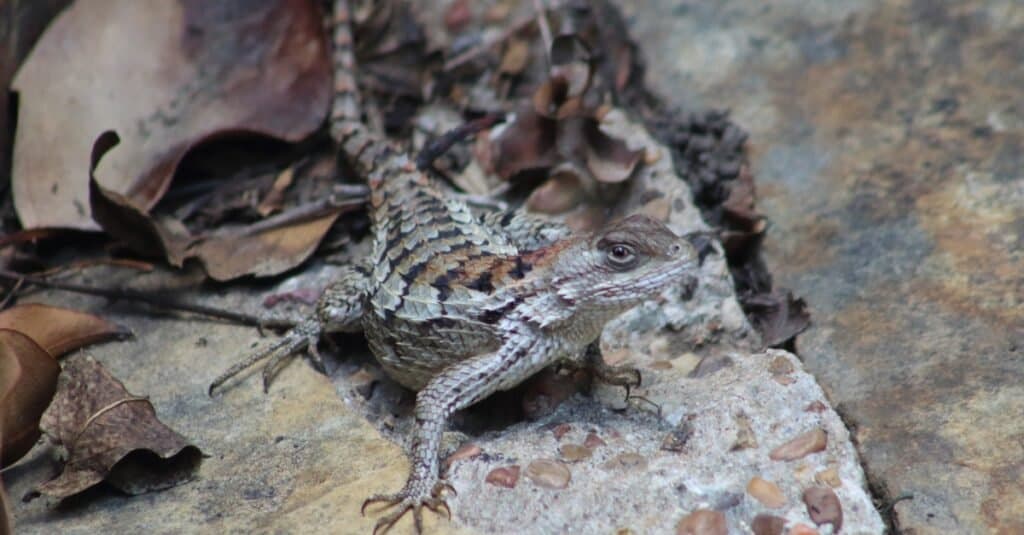
iStock.com/Wytenite
Texas Spiny Lizard Behavior
Texas spiny lizards are diurnal hunters who spend most of their time in trees or hiding in leaf litter. During hot daylight hours, they often come out to bask in the sunshine on tree branches or fence posts. That’s why some people call them “tree lizards” or “fence lizards.”
They are shy and elusive, and it can be hard to see them. If a large animal enters their territory, they are more likely to run and hide than fight.
Male spiny lizards are territorial and will fight with other males for territory and females. When they fight, they square off against each other and compete by doing push-ups. Both males will do push-ups until one gives up and runs away.
Spiny lizards often use their tails to defend themselves from predators. If the predator grabs the tail, the tail will detach from the lizard’s body. This is a defensive mechanism known as automatization. The tail distracts the predator, and this gives the lizard time to run to safety. Later, the lizard will grow a new tail.
Male vs female fights do not occur among spiny lizards.
Hibernation
Texas spiny lizards hibernate in the winter. They begin their hibernation during the cold winter months. They use leaf litter and other ground covers to hide until the weather gets warm again. Many gardeners take advantage of this by placing leaf litter in their gardens to encourage spiny lizard hibernation. In the spring, the hungry lizards get busy eating insects in the garden.
Behavior around humans
Texas spiny lizards are a favorite among many Texans and others who appreciate their cute behavior and ability to gobble up insect pests. They do not bite and are not poisonous.
Texas Spiny Lizard Habitat
These lizards spend most of their time in trees. They prefer mesquite trees but will take up residence in any type of scrub vegetation. They look for areas with plenty of leaf litter, which supplies cover and a fertile hunting ground for insects. Typically, they can be found in shrubland, forests, and other areas with dense tree growth.
Their colors allow them to camouflage themselves against tree bark and leaf litter. These lizards prefer tropical, temperate climates with plenty of sunshine.
Texas Spiny Lizard Diet
Texas Spiny Lizards are carnivores that largely feed on small insects. They eat beetles, wasps, grasshoppers, and crickets.
Texas Spiny Lizard Predators and Threats
Like most lizards, these lizards can be prey for snakes, weasels, raptors, and larger lizards. The Texas spiny lizard does not face any current threats. It is a common lizard that has a healthy, stable population.
Texas Spiny Lizard Reproduction and Life Cycle
The spiny lizard’s breeding season happens during spring and summer. A female can have up to four clutches every year. Each clutch has from 4 to 20 eggs.
Gestation takes 90 to 100 days. When she’s ready to have the babies, she chooses a warm, dry spot in the ground. Once she chooses the right spot, she digs a small hole in the ground and backs up into it. She lays the eggs and covers them with soil.
The incubation period takes 43 to 83 days. The female does not return to the nest after depositing the eggs.
Young spiny lizard hatchlings are precocial, which means they are fully developed and able to live independently. They are 2 to 3 inches long at birth.
They have a lifespan of 2 to 5 years in the wild. Their lifespan in captivity is about 7 years.
Population
The exact population numbers of the spiny lizard are unknown, but the population is considered stable and healthy.
Conservation Status
These lizards are listed as “least concern” under the International Union for the Conservation of Nature (IUCN).
Enjoy These Sun-Loving Visitors
These lizards are common visitors to trees, forests, and gardens. If you’re lucky, you may be able to watch a push-up competition right in your backyard.
View all 74 animals that start with T
Texas Spiny Lizard FAQs (Frequently Asked Questions)
Are Texas spiny lizards poisonous?
No, they are not poisonous.
Do Texas spiny lizards play dead?
No, they do not play dead. They hibernate in the winter, however.
Do Texas spiny lizards bite?
No, Texas spiny lizards do not bite humans. They are harmless to humans. Many people appreciate the way they control insect pests in their yards.
How do I get rid of Texas spiny lizards?
It’s not necessary to get rid of them. If you see them in your yard, enjoy these harmless, helpful critters who are there to eat unwanted bugs in your garden.
What do Texas spiny lizards eat?
They eat small insects. Their diet includes grasshoppers, crickets, blister beetles, June beetles, spiders, mites, and flies.
How do I catch a Texas spiny lizard?
These shy lizards can be difficult to catch because they are shy and elusive. They also have colors that provide excellent camouflage. One way to catch them is to set up a trap using cricket heads as bait.
How do I care for a Texas spiny lizard?
If you want to keep one as a pet, be sure you have a large enclosure that gets plenty of heat and sunlight. Learn the facts about proper reptile care before you get one.
The enclosure should be at least 3 feet long, 2 feet wide, and 2 feet deep. To keep your pet lizard happy, be sure to provide
• Several tree branches for climbing and basking
• Leaf litter for a natural habitat
• Branches, vines, sticks, and logs
• Open area for running around
• One or two cooler hiding spots
To feed them, serve them crickets and other insects. Twice a week, dust the insects with a vitamin D and calcium supplement. They can eat worms, but don’t feed them mealworms.
How do I mate a Texas spiny lizard?
You can mate a Texas spiny lizard by placing a male and female together in an enclosure. You should be prepared to take care of their hatchlings when they come out.
What are the differences in male vs female spiny lizards?
The main male vs female difference is their colors. Identification of males is easy because only males have small blue patches on their bellies.
Sources
- University of Texas, Available here: https://biodiversity.utexas.edu/news/entry/backyard-biodiversity-texas-spiny-lizard
- Landmark Wildlife Management, Available here: https://landmarkwildlife.com/a-little-bit-about-the-texas-spiny-lizard/
- Learn About Nature, Available here: https://www.pet-lizard.com/texas-spiny-lizard.html



